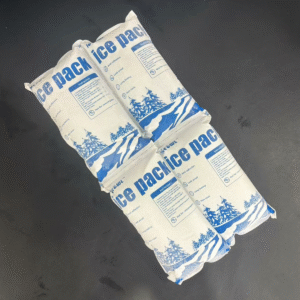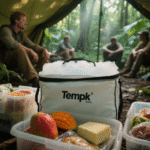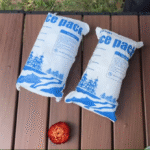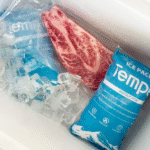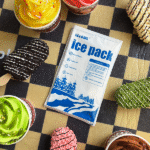Bolsa de hielo seco para transporte de vacunas: Cómo elegir y utilizar
Ensuring vaccines remain at the correct temperature during transport is a critical part of healthcare logistics. En 2025, Las bolsas de hielo seco siguen siendo una herramienta vital para mantener temperaturas ultrabajas para las vacunas., como las vacunas de ARNm COVID-19, que requieren refrigeración entre -70°C y -80°C. Esta guía ofrece una descripción general completa sobre cómo seleccionar las bolsas de hielo seco adecuadas., manipularlos y almacenarlos de forma segura, y cumplir con las últimas regulaciones para garantizar la seguridad, transporte eficiente de vacunas.
-
¿Por qué son dry ice packs essential for vaccine transport?
-
¿Cómo se selecciona la bolsa de hielo seco adecuada para su envío??
-
¿Qué precauciones de seguridad debe tomar al manipular hielo seco para el envío de vacunas??
-
Cómo almacenar y utilizar hielo seco de forma segura durante el transporte?
¿Por qué las bolsas de hielo seco son esenciales para el transporte de vacunas??
Las bolsas de hielo seco son fundamentales para el transporte de vacunas que requieren temperaturas ultrabajas. Vaccines like the Pfizer-BioNTech COVID-19 vaccine must be kept between -70°C and -80°C, making dry ice an essential tool. El hielo seco se sublima a -78.5 ° C, which is ideal for ensuring vaccines remain within the required temperature range during transit.
By using dry ice ice packs, you can extend the shelf life of vaccines, preventing exposure to temperature fluctuations that could compromise their efficacy. This ensures that vaccines arrive at their destination in optimal condition, reducing the risk of ineffective immunizations.
What Makes Dry Ice Ideal for Vaccine Shipments?
Dry ice offers several advantages for vaccine transport:
-
Maintains Consistent Low Temperatures: Dry ice is perfect for ultra-cold storage, especially for vaccines requiring temperatures below freezing.
-
Sin residuos líquidos: A diferencia del hielo normal, El hielo seco se sublima en gas, leaving no liquid that could damage packaging or cause leaks.
-
Enfriamiento duradero: Dry ice lasts longer than gel packs or ice, making it ideal for long-distance and international shipments.
| Característica | Paquetes de hielo seco | Gel Packs or Regular Ice | Lo que esto significa para ti |
|---|---|---|---|
| Rango de temperatura | -78.5°C | 0° C a -5 ° C | Ensures vaccines stay frozen or chilled |
| Tasa de sublimación | 5-10 libras cada 24 horas | Se derrite en líquido | No leaks or residue |
| Durabilidad | Lasts longer during transit | Vida útil más corta | Reliable for long shipments |
Practical Usage Tips
-
Para envíos de larga distancia: Use larger or multiple dry ice packs to maintain a consistent temperature during extended transportation.
-
For Different Vaccine Types: Different vaccines require different temperature settings. Make sure to select the appropriate dry ice solution based on the specific temperature threshold of the vaccine.
-
For Sensitive Packaging: Combine dry ice with insulated shipping containers to optimize cooling and protect vaccines.
Caso real: A global health organization reported that using dry ice ice packs for vaccine transport improved shipment efficiency by 25%, ensuring vaccines arrived on time and within the required temperature range.
How Do You Select the Right Dry Ice Ice Pack for Vaccine Shipments?
Choosing the correct dry ice ice pack is crucial to maintaining the safety of vaccines. Consider these factors when selecting a dry ice solution for vaccine transport:
Key Considerations for Dry Ice Selection
-
Duración de envío: Los envíos más largos requieren más hielo seco. Larger packs or multiple smaller packs will be necessary for longer trips.
-
Tamaño de embalaje: The size of the shipping container affects the amount of dry ice required. Ensure the container can accommodate the packs while maintaining insulation.
-
Temperatura externa: If the shipment is exposed to higher temperatures, ensure enough dry ice is used to maintain the required cold.
Recommendations for Choosing Dry Ice Packs
-
Para shorter transit times, smaller dry ice packs may suffice. Para envíos más largos, opt for larger or multiple packs.
-
Calculate the dry ice requirements based on the shipment’s duration and the vaccines’ temperature needs.
-
Usar contenedores aislados designed to work efficiently with dry ice to minimize waste and ensure stable temperatures.
Safe Storage and Handling of Dry Ice During Vaccine Shipping
Proper storage and handling of dry ice are essential for safety. Dry ice can pose risks like frostbite and asphyxiation if mishandled, so it’s crucial to follow safety guidelines.
Safety Guidelines for Dry Ice Handling
-
Ventilación: Guarde siempre el hielo seco en un área bien ventilada para evitar la acumulación de dióxido de carbono..
-
Equipo de protección: Wear insulated gloves and protective clothing to prevent frostbite and cold burns.
-
Desecho: Dispose of unused dry ice by allowing it to sublimate in an outdoor space. Nunca deseche el hielo seco en contenedores sellados..
| Protocolo de seguridad | Descripción | Tu acción |
|---|---|---|
| Ventilación | Almacenar en un área bien ventilada. | Evite espacios reducidos |
| Equipo de protección | Utilice guantes y gafas aislantes. | Prevent frostbite or cold burns |
| Métodos de eliminación | Permita que el hielo seco se sublime al aire libre | Ensure safe disposal in open air |
Consejos prácticos de seguridad para el envío
-
Etiquetado adecuado: Label packages containing dry ice to alert recipients and carriers.
-
Shipping Container: Utilice resistente, vented containers to prevent gas buildup and protect vaccines.
-
Capacitación: Ensure that personnel are trained in dry ice handling and safety procedures.
2025 Developments and Trends in Dry Ice for Vaccine Transport
The cold chain industry continues to innovate, making dry ice transport even safer and more efficient. Here are some 2025 tendencias:
-
Sensores de temperatura inteligentes: Smart sensors track the temperature of shipments in real time, garantizar que las vacunas permanezcan a la temperatura correcta.
-
Blockchain para transparencia: Blockchain technology improves traceability, making it easier to ensure vaccines are stored and transported correctly.
-
Eco-Friendly Dry Ice Solutions: More companies are adopting carbon-neutral dry ice production to meet sustainability goals.
Información clave del mercado
The cold chain logistics market is expected to reach $600 mil millones por 2025. As demand for vaccines and biologics grows, dry ice solutions will remain essential in ensuring safe and effective transport.
Preguntas frecuentes
Q1: How long does dry ice last when shipping vaccines?
El hielo seco generalmente dura 24-48 horas, depending on the size of the pack and the insulation of the container. Para duraciones más largas, larger packs or multiple packs may be necessary.
Q2: Is dry ice safe for transporting all types of vaccines?
Dry ice is used for vaccines requiring ultra-low temperatures, como las vacunas de ARNm. It is not suitable for routine vaccines that need to stay between 2°C and 8°C.
Q3: How should dry ice be stored during transit?
Dry ice should be stored in well-ventilated containers to allow the gas to escape and prevent pressure buildup. Always use containers designed for dry ice transport.
Resumen y recomendaciones
Dry ice ice packs are crucial for maintaining vaccines at the correct temperature during transport. Choose the right size of dry ice pack, calculate the dry ice requirements, and follow safety protocols to ensure vaccines arrive safely.
Pasos de acción
-
Assess the temperature and duration requirements for your vaccine shipments.
-
Train staff on safe dry ice handling.
-
Invest in temperature monitoring devices to ensure optimal conditions throughout transport.
Acerca de Tempk
Y tempk, we specialize in providing high-quality dry ice solutions for vaccine transport. Our innovative technology ensures that vaccines are delivered on time and within the required temperature range. Contact us today for customized solutions and to learn more about our services.






